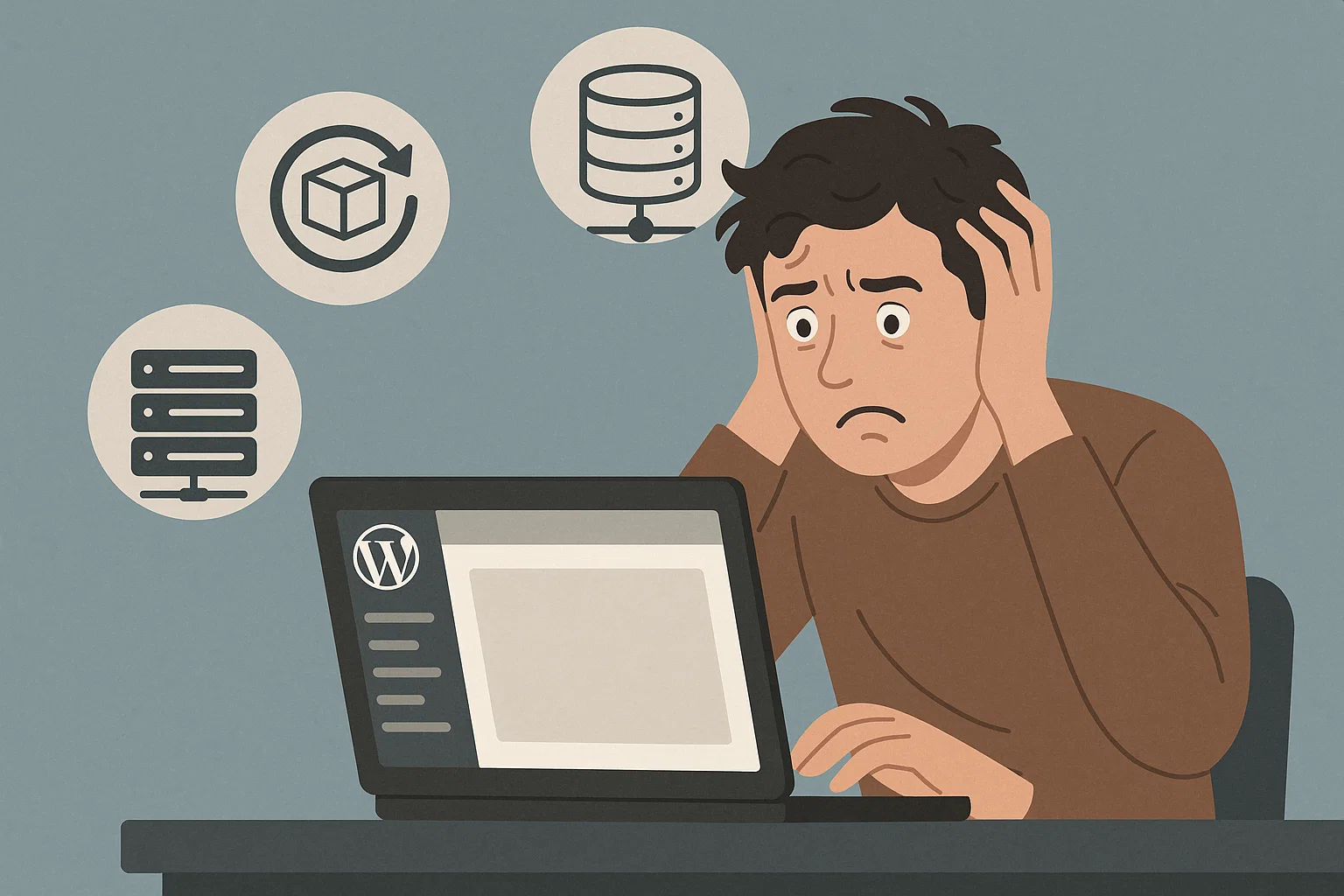 You’re sitting at your laptop, sipping your morning coffee, ready to check yesterday’s traffic spike. You log into WordPress and, bam, your favourite post is gone. Or maybe your whole site is showing a white screen of death. Panic sets in.
You’re sitting at your laptop, sipping your morning coffee, ready to check yesterday’s traffic spike. You log into WordPress and, bam, your favourite post is gone. Or maybe your whole site is showing a white screen of death. Panic sets in.
I’ve been there. Back in 2018, I lost 14 posts in one night because my hosting provider messed up a migration. At first, I thought they were gone forever. But after hours of digging, I managed to restore every single one. That’s when I realised: most lost blog posts are recoverable, if you know where to look.
This isn’t just a guide. It’s your emergency toolkit. Whether you’re running a WordPress blog, a Blogger site, or hosting with providers like Hostinger, cPanel, or GoDaddy, this will walk you through every possible way to restore deleted or lost content.
So, breathe. Let’s fix your blog.
Why Blog Posts Disappear in the First Place
Before we jump into fixes, it helps to know why this happens. Here are the top causes:
Hosting Downtime or Server Failure
Sometimes the issue isn’t you. A server crash, maintenance glitch, or migration gone wrong can wipe posts temporarily or corrupt the database.Example: When Hostinger had a major outage in 2021, many bloggers logged in to blank dashboards. Their posts weren’t deleted but the database connection failed.
Expired Hosting or Domain
If you forget to renew hosting or a domain, providers may suspend or clear your site data.Accidental Deletions
One wrong click in WordPress, and an entire post can vanish.Plugin or Theme Conflicts
Installing a faulty plugin or updating a theme can corrupt tables likewp_postsin your database.Database Corruption
Issues inphpMyAdminor errors during updates can cause missing posts.
Knowing the “why” helps you choose the right recovery method.
Step 1: Check the Trash First
This sounds obvious, but you’d be surprised how many people overlook it.
In WordPress:
Go to Dashboard → Posts → All Posts.
At the top, click on Trash.
If your post is there, hover over it and click Restore.
Example: I once thought I lost a tutorial on SEO-friendly images. Turned out I’d hit “Move to Trash” while editing. Restoring took 10 seconds.
In Blogger:
Login → Click on Posts.
Scroll down to the Removed section.
Restore the post if available.
Blogger only keeps posts in Trash for 30 days. After that, they’re gone unless you have backups.
Step 2: WordPress Revisions – Your Secret Time Machine
Every time you save or update a post, WordPress quietly stores a copy in Revisions.
Open the post editor.
On the right sidebar, look for Revisions.
Click it, and you’ll see a timeline of saved versions.
Compare drafts and click Restore This Revision.
Real-life example: A client overwrote his affiliate review with a new draft. He panicked, thinking he’d lost 3,000 words. Revisions brought back the original within minutes.
This feature is a lifesaver for accidental edits.
Step 3: Restore from Hosting Backups
If Trash and Revisions don’t help, it’s time to pull out the big guns: backups.
a) Hostinger’s Backup System
Hostinger offers daily and weekly backups on most plans.
Log into your Hostinger account.
Go to hPanel → Files → Backups.
Choose a backup date (before the loss happened).
Click Restore Files or Restore Database.
Screenshot-style steps:
I once helped a blogger restore her travel site after a plugin conflict broke half her posts. Hostinger rolled back the database to the previous night’s backup, problem solved.
b) cPanel File Manager & phpMyAdmin
If you’re on cPanel hosting (Bluehost, SiteGround, etc.), here’s how:
File Manager Method
Log into cPanel.
Click File Manager.
Go to the folder
/public_html/.Check if you have a
backupsfolder or older.zipfiles.Extract and replace missing files.
Database Restore with phpMyAdmin
In cPanel, click phpMyAdmin.
Select your database.
Click Import.
Upload a
.sqlbackup file.
This restores your posts because WordPress posts are stored in the wp_posts table.
c) Backup Plugins
If you had plugins installed, this is the easiest route.
UpdraftPlus:
Dashboard → Settings → UpdraftPlus Backups.
Choose the backup date.
Click Restore (files, database, or both).
Jetpack Backups (VaultPress):
Jetpack keeps real-time backups (on premium plans). One click restores your entire site.All-in-One WP Migration:
If you exported your site earlier, just import the file back.
Pro Tip: Always schedule automatic backups. Even free versions can save your sanity.
Step 4: Ask Your Hosting Provider
If you can’t find backups yourself, don’t give up. Hosting providers often keep server-level backups for emergencies.
Write to support something like this:
“Hi, my WordPress posts disappeared due to hosting issues. Could you please restore my site to [date]?”
Most providers will happily restore your site within hours.
Step 5: Google Cache & Wayback Machine Rescue
Let’s say you didn’t keep backups. Google might have done it for you.
Google Cache
Search your post title in Google.
Click the three-dot menu or small arrow → Cached.
Copy the post content into WordPress.
Wayback Machine (archive.org)
Enter your URL.
Select a snapshot from the calendar.
Copy and paste the content.
Example: A friend lost his Blogger poetry blog. Using Wayback Machine, we retrieved 70% of his work. It wasn’t perfect, but it saved him months of rewriting.
Step 6: Recovering Deleted Pages or Plugins
WordPress Pages
Pages follow the same rules: Trash, Revisions, or backups.
Plugins
If you deleted a plugin:
Go to Dashboard → Plugins → Add New.
Re-install it.
If settings are gone, restore from backups.
Database Trick: Many plugins store settings in wp_options. If you can restore this table, your settings come back too.
Step 7: Blogger-Specific Recovery
For Blogger users:
Trash Check – look under Posts → Removed.
Google Takeout – Google’s export tool lets you download your blog data. If you did this earlier, re-import your content.
Cache/Wayback Machine – grab old posts and rebuild manually.
Blogger doesn’t have as many safety nets as WordPress, so caching tools are extra important.
Step 8: Prevent Future Disasters
Once you’ve recovered your posts, lock the doors so it doesn’t happen again.
Set Automatic Backups. At least weekly.
Keep Offline Copies. Save drafts in Google Docs or Word.
Use Staging Sites. Test plugins/themes safely.
Pick Reliable Hosting. Cheap hosts often skip proper backups.
Limit Plugin Bloat. Fewer plugins = fewer conflicts.
Quick Troubleshooting Table
| Issue | Fix | Tool Needed |
|---|---|---|
| WordPress post deleted | Check Trash, Revisions | WP Dashboard |
| Site crashed due to hosting | Restore from cPanel/Hostinger | Hosting Backup Tools |
| Lost Blogger post | Google Takeout, Cache | Google Tools |
| Deleted plugin data | Re-install + DB restore | phpMyAdmin |
| Lost WP page | Trash, Revisions, Backups | WP + Hosting Tools |
Final Words of Relief
Losing posts feels like losing memories. But here’s the truth: 99% of the time, they’re not really gone. Between Trash, Revisions, backups, and Google’s cache, you’ve got multiple lifelines.
And even if you only recover parts of a post? Don’t throw them away. Tools like a Paraphrasing Tool
Your blog is your digital home. Guard it with backups, stay calm when things go wrong, and remember, you’re never more than a few clicks away from recovery.

Alex WebPro, your guide to web mastery. Expert tips on WordPress, SEO, monetization, and the best in design trends and themes.